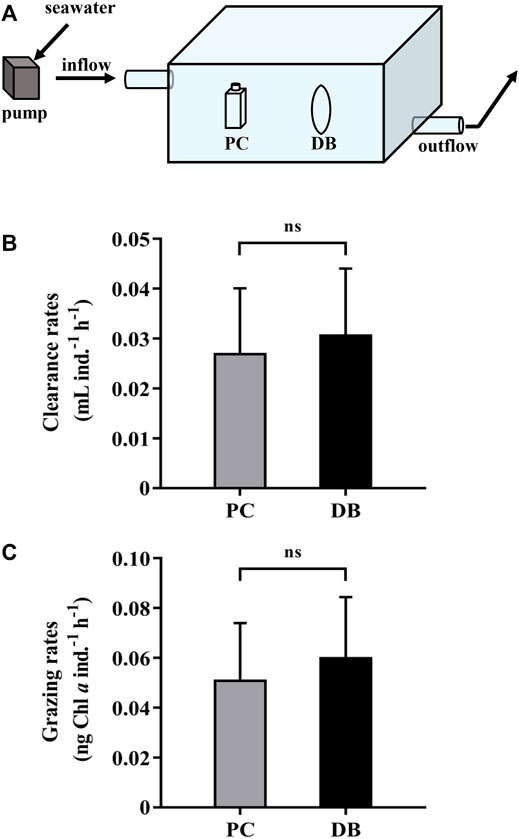
95% of researchers rate our articles as excellent or good
Learn more about the work of our research integrity team to safeguard the quality of each article we publish.
Find out more
CORRECTION article
Front. Physiol. , 15 June 2022
Sec. Aquatic Physiology
Volume 13 - 2022 | https://doi.org/10.3389/fphys.2022.940603
This article is part of the Research Topic Methods and Applications in Aquatic Physiology View all 7 articles
This article is a correction to:
Applying Dialysis Bags to Grow Microalgae and Measure Grazing Rates by Secondary Producers
A Corrigendum on
Applying Dialysis Bags to Grow Microalgae and Measure Grazing Rates by Secondary Producers
by Tian Y, Yi X and Gao K (2022). Front. Physiol. 13:838001. doi: 10.3389/fphys.2022.838001
In the original article, there was an error in the second paragraph of Section 2.4: Measuring Grazing Rates of a Heterotrophic Dinoflagellate by Applying the Dialysis Bags. The error occurred in the unit of grazing rates of Noctiluca scintillans, μg Chl a ind.−1 h−1, which should be corrected as ng Chl a ind.−1 h−1.
The corrected paragraph is as follows:
“The clearance and grazing rates of the heterotrophic dinoflagellate, N. scintillans, measured using the dialysis bags were respectively 0.031 ± 0.013 mL ind.-1 h-1 and 0.060 ± 0.024 ng Chl a ind.-1 h-1, slightly higher but not statistically different from those obtained by PC bottles, which were 0.027 ± 0.013 mL ind.-1 h-1 and 0.051 ± 0.023 ng Chl a ind.-1 h-1 (Figure 3B, C). At the end of the test, the nutrients in the dialysis bags maintained a relative high level, attributed to the replenishment by in-situ seawater, while DIN and SRP concentrations in the closed PC bottles were about 90% lower than those in the dialysis bags (Table 1). Consequently, using the dialysis bag to determine grazing rates is reliable even for prolonged incubation, since the membrane is permeable to nutrients and small molecules, changes of which could be tremendous in the sealed containers used in the traditional method (Table 1).”
In there was the same error in Figure 3C as published. The unit of grazing rates of Noctiluca scintillans, μg Chl a ind.−1 h−1, should be corrected as ng Chl a ind.−1 h−1. The corrected Figure 3 appears below.

FIGURE 3. (A) A water bath with in situ seawater running through in which the dialysis bags and sealed bottles were incubated to measure and compare the grazing rates. (B) The clearance rates and (C) grazing rates of the heterotrophic dinoflagellates Noctiluca scintillans on natural phytoplankton assemblages during 1-day incubation by using polycarbonate bottles (PC, grey bars) and dialysis bags (DB, black bars). Data are the means ± SD, n = 3 (3 different replicates). Independent samples t-test was used to test the difference in the clearance and grazing rates of N. scintillans between the methods, and the differences were considered to be statistically significant at p < 0.05. The abbreviation ns stands for non-significant differences.
The authors apologize for this error and state that this does not change the scientific conclusions of the article in any way. The original article has been updated.
All claims expressed in this article are solely those of the authors and do not necessarily represent those of their affiliated organizations, or those of the publisher, the editors and the reviewers. Any product that may be evaluated in this article, or claim that may be made by its manufacturer, is not guaranteed or endorsed by the publisher.
Keywords: grazing rate, phytoplankton, zooplankton, secondary producer, dialysis bag
Citation: Tian Y, Yi X and Gao K (2022) Corrigendum: Applying Dialysis Bags to Grow Microalgae and Measure Grazing Rates by Secondary Producers. Front. Physiol. 13:940603. doi: 10.3389/fphys.2022.940603
Received: 10 May 2022; Accepted: 16 May 2022;
Published: 15 June 2022.
Edited and reviewed by:
Menghong Hu, Shanghai Ocean University, ChinaCopyright © 2022 Tian, Yi and Gao. This is an open-access article distributed under the terms of the Creative Commons Attribution License (CC BY). The use, distribution or reproduction in other forums is permitted, provided the original author(s) and the copyright owner(s) are credited and that the original publication in this journal is cited, in accordance with accepted academic practice. No use, distribution or reproduction is permitted which does not comply with these terms.
*Correspondence: Kunshan Gao, a3NnYW9AeG11LmVkdS5jbg==
Disclaimer: All claims expressed in this article are solely those of the authors and do not necessarily represent those of their affiliated organizations, or those of the publisher, the editors and the reviewers. Any product that may be evaluated in this article or claim that may be made by its manufacturer is not guaranteed or endorsed by the publisher.
Research integrity at Frontiers

Learn more about the work of our research integrity team to safeguard the quality of each article we publish.